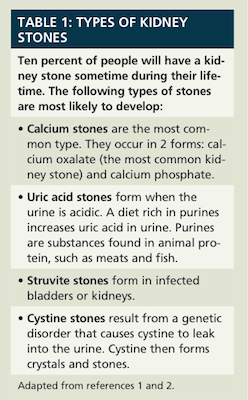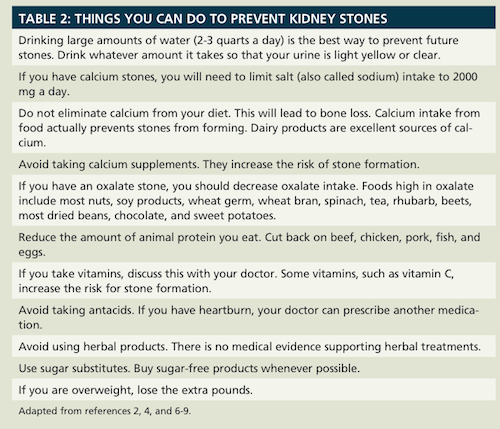Article
Kidney Stones
Author(s):
What Causes Kidney Stones?
Kidneys are bean-shaped organs. Each person is born with 2 kidneys, which are located in the mid to lower back, with 1 kidney on each side. Kidneys filter blood and remove waste.
Kidney stones are hard objects that are made from chemicals in the urine. When there is too little urine and a lot of waste, chemicals begin to form crystals. These crystals attract other chemicals that form a hard mass resembling a stone. Most stones are formed in the kidneys. When large stones leave the kidneys, they get stuck in the tube that connects the kidney to the bladder. This tube is called the ureter.

There are several types of stones, which can be smooth or jagged. Different stones contain different chemicals (Table 1). If you pass a stone, try to retrieve it and take it to your doctor. Knowing the type of stone you passed helps determine treatment options.
What Are the Symptoms of Kidney Stones?
Small stones are usually passed without any symptoms. Medium to large stones eventually begin to move from the kidney to the ureter, where they get stuck. The main symptom is severe pain on either side of the back. This pain results from the body’s attempt to move the stone out of the ureter and into the bladder. Many people describe the pain as the worst they have ever experienced. Pain often spreads to the lower stomach area and the groin. The pain comes and goes, lasting 20 to 60 minutes. Other symptoms may include fever, vomiting, nausea, diarrhea, blood in the urine, burning sensation when urinating, and frequent urges to urinate.3,4
Why Do Some People Get Kidney Stones?
We know kidney stones run in families. If your parents or siblings had kidney stones, you have a higher risk of developing a kidney stone. Eating a diet high in salt, sugar, and animal protein is also associated with kidney stone formation.5
Some medical conditions and medications increase the risk for stone development. Medical conditions that increase the risk include high blood pressure, bladder infection, obesity, and diseases of the intestine and colon. Medications that increase the risk include drugs to treat HIV/AIDS and chemotherapy.4
What Is the Treatment?
The first goal of treatment is to remove kidney stones that are stuck in the kidney, ureter, or bladder. The second goal is to treat the pain. The third goal is to prevent future stones from forming.
If you have a kidney stone that is stuck in the ureter, you will be asked to drink lots of water in a short period of time to “flush out” the stone. Minor pain is treated with OTC pain relievers. If pain is severe, you will be given a prescription pain medication. If the stone does not pass within 5 to 7 days, your doctor may try to break it into smaller pieces by using a machine that delivers shockwaves to the stone. This procedure does not work for large stones, which must be removed in a hospital. Your doctor will insert a scope (a tube with an eyepiece) and a laser into your genitals, up to the bladder, and into the ureter. The stone is then removed or broken into smaller pieces. Extremely large stones require surgery. A small incision is made into the back so the surgeon has direct access to the kidney and ureter.
Once kidney stones are removed, your doctor may prescribe medication to prevent future stones. The choice of medication depends on the composition of the stone. Medications are not 100% effective. Even with treatment, there is a 50% chance of having a second stone 5 to 7 years after the first episode.2
Can Dietary Changes Help?
Diet can play a key role in preventing kidney stones. Table 2 lists several things you can do to prevent kidney stones.

Dr. Zanni is a psychologist and health systems consultant based in Alexandria, Virgini
References
- National Kidney and Urologic Diseases Information Clearinghouse. Kidney stones in adults. http://kidney.niddk.nih.gov/kudiseases/pubs/stonesadults/. Accessed June 22, 2013.
- National Kidney Foundation. Kidney stones. www.kidney.org/atoz/content/kidneystones.cfm. Accessed June 22, 2013.
- Zanni G. Management and prevention of kidney stones. Pharm Times. 2006;8:102-104.
- Disease Symptoms & Treatment. Kidney stones. www.disease-symptoms-treatment.com/kidney-stones.html. Accessed June 22, 2013.
- Mayo Clinic Staff. Kidney stones. www.mayoclinic.com/health/kidney-stones/DS00282. Accessed June 22, 2013.
- National Kidney Foundation. Diet and kidney stones. www.kidney.org/atoz/content/diet.cfm. Accessed June 22, 2013.
- National Kidney Foundation. 6 easy ways to prevent kidney stones. www.kidney.org/atoz/content/kidneystones_prevent.cfm. Accessed June 22, 2013.
- National Kidney and Urologic Diseases Information Clearinghouse. Diet for kidney stone prevention. www.kidney.niddk.nih.gov/kudiseases/pubs/kidneystonediet/. Accessed June 22, 2013.
- Sakhaee K, Maalouf NM, Sinnott B. Clinical review. Kidney stones 2012: pathogenesis, diagnosis, and management. J Clin Endocrinol Metab. 2012;97(6):1847-1860.





